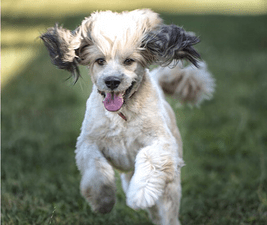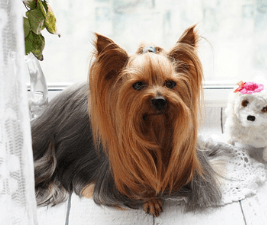Dogs and people have a lot in common. That’s probably why they’ve chosen to live with us. And every single day, we’re grateful we have dogs in our lives. They’re wonderful listeners, also great at being quiet. They’re clowns when you’re feeling silly, and empathetic cuddlers when you’re low. We feel badly for people who don’t have dogs. Especially since they may not figure out the great things we can learn from dogs.
#5: Eat with Gusto!
We know that there are finicky dogs, but we’ve been lucky that all of our dogs eat heartily – whatever we put in front of them. They’re always eager to dive into their food, even if we think it’s a disgusting, smelly bowl of glop. The added lesson learned from dogs here is that we should be grateful and appreciate whatever we’re given. It’s kind of a hassle when the dogs crowd around when you’re fixing their meals, but the happy faces and wagging tails (for dogs with tails!) make us smile. Most families seem to have a meal-time ritual, and a phrase that cues everyone to run to their designated meal spot. Ours is “Who want to eat?” And our advice is to stay out of their way when they hear it!
#4: Notice Stuff
Dogs notice anything new in their surroundings. Just yesterday, Simon proved the point. We’d put a brick on the lid of the outside “poop bucket” because heavy winds were expected. And the last thing anyone wants is the lid of the poop bucket flying off! But he hadn’t seen it before and was absolutely fascinated. At first, he approached with caution, did some sniffing, and decided it was harmless. But he noticed.
People aren’t quite as good at being aware of their surroundings. Lots of people walk their dogs down our block. Most of the people have the leash in one hand and are looking at their phones in the other. The dogs are checking the area, sniffing, watching, listening, and sometimes even glancing at their people. We will admit that the people do seem to pay attention when their dog stops to make a deposit. And we’re grateful they’re good about cleaning it up.
But it’s not all about the nasty stuff. Dogs stop and sniff the flowers, watch the butterflies, and stand at attention to follow squirrels with their eyes.
#3: Expect Treats Regularly
Dogs have to be considered optimists. They’re always hopeful that good things are coming their way. Even when there’s no reasonable expectation it will happen. Of course they do have incredibly powerful weaponry with those puppy-dog eyes. It’s hard to resist the hopeful expressions and rapt attention. And it usually works. When they look at you with the absolute conviction that you’re wonderful, it’s awfully hard to say no.
#2: Show People You’re Delighted to See Them
Even if all we’ve done is take out the garbage, the dogs are truly delighted to see us again. It doesn’t matter if we’re gone for five minutes or several hours. They’re just happy we’re there. Even if you get annoyed by the dog jumping on you, or getting in your way, it’s still flattering that someone’s so thrilled with your presence. Everyone could use an ego boost now and again. Dogs are great at supplying it, just when you could use it.
#1: Live In The Moment
It’s probably the most important lesson to learn from dogs. Dogs don’t worry about what may or may not happen. They don’t regret things that have already passed. Dogs live in the here and now being happy as they can be. This quality is particularly noticeable with dogs who have some kind of disability. They don’t agonize over it, they just get on with life. We saw this when our Brussels Griffon Razzmatazz suddenly went blind. We did get him a “hoop” harness so he wouldn’t bang his head on stuff. And when he realized what it was for, he ran around just as if he could see. He delighted in banging that hoop against our shins to let us know he’d appreciate one of those treats now. And he usually got it.
Learn from dogs
We know dogs don’t have the same life experience people do. We define their world for them. But we can still take a hint or two from the way they live, full-on, enjoying what they have and not worrying about what they don’t.
Enjoyed this post? Click here to sign up for the weekly newsletter and never miss another!












